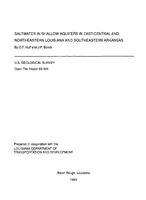The chemistry of water from irrigation and monitor wells in east-central Louisiana indicates the presence of saltwater in the Mississippi River alluvial aquifer and the uppermost part of the Jasper aquifer system. The salinity of this groundwater makes it unsuitable for use in irrigation of salt-sensitive crops. The geochemistry of bromide (Br) and chloride (Cl) ions and strontium (Sr) isotopes indicated that this saltwater could have originated from the mixing of freshwater with briny water originating from the Carrizo-Wilcox aquifer at altitudes from 5,800 to 6,800 feet below sea level. However, in the absence of data on the concentrations of Br and Cl ions and the values of (87)Sr/(86)Sr in water from the Catahoula, Cockfield, and Sparta aquifers within the study area, no conclusive statement can be made on the origin of saltwater in the alluvial aquifer and the uppermost part of the Jasper aquifer system. Analyses of water from irrigation wells in northeastern Louisiana and southeastern Arkansas indicated the presence of saltwater in the Mississippi River alluvial aquifer. Saltwater probably moves from southern Chicot County, Arkansas, into northeastern Louisiana by flowing to the southwest along a fluvial channel eroded into the Cockfield Formation. Saltwater in the Mississippi River alluvial aquifer in northeastern Louisiana and southeastern Arkansas can be hazardous to salt-sensitive crops, such as rice, when used for irrigation. The geochemistry of Br and Cl ions indicated that saltwater in the Mississippi River alluvial aquifer of southern Chicot County in southeastern Arkansas has two geochemically distinct sources. One source, which has Br/Cl ratios less than that of modern seawater, could be derived from saltwater present in aquifers of Tertiary age; this saltwater could enter the alluvial aquifer by upward flow from below as part of the natural regional groundwater flow pattern. The other source, which has Br/Cl ratios greater than that of modern sea- water, could be derived, in part, from briny water present in the Smackover Formation at altitudes from 5,500 to 6,500 feet below sea level. This briny water could enter the alluvial aquifer by upward migration along a fault that penetrates from near land surface into the Smackover Formation.


